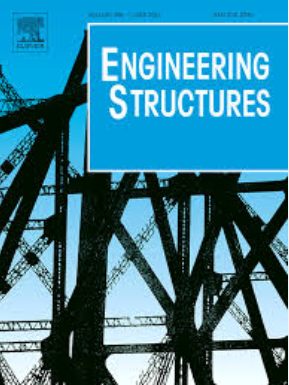不锈钢(SS)螺纹钢与海水海砂混凝土(SSC)的粘结行为:实验与建模
IF 5.6
1区 工程技术
Q1 ENGINEERING, CIVIL
引用次数: 0
摘要
本文章由计算机程序翻译,如有差异,请以英文原文为准。
Bond behavior of stainless steel (SS) rebar to seawater sea-sand concrete (SSC): Experiments and modeling
The stainless steel (SS) rebar is attractive for reinforcing seawater sea-sand concrete (SSC) due to its desirable corrosion resistance. This study presents a central pull-out test program involving 44 specimens to explore the bond behavior of SS rebar to SSC. Several test parameters, such as concrete type and strength, bar type, anchorage length, concrete cover, and stirrup ratio, were comprehensively discussed to investigate their effects on failure modes, bond-slip responses, and ultimate bond strength. Experimental results show that concrete cover, anchorage length, and concrete strength all play a significant role in failure modes. The bond strength of SS rebar is enhanced with the increase in compressive strength of SSC. Nevertheless, inferior bond strength is detected for SSC specimens compared to the normal concrete (NC) counterparts with the same pre-designed concrete strength regardless of bar type. The average bond strength tends to increase with a decreasing anchorage length and increasing concrete cover. In addition, the use of stirrups can also enhance the bond strength by at least 19.32 % compared to the unstrengthened specimens. By taking into account the similar confinement effect provided by the concrete cover and internal stirrups, a unified confinement coefficient is adopted in the ultimate bond strength model and the design anchorage length. Finally, the bond interface is assumed to consist of unlimited spring and friction elements, and a new bond-slip model is proposed based on stochastic damage theory. The proposed model can reasonably reveal the randomness and nonlinearity of bond-slip responses, and a good agreement is also detected by comparing the theoretical predictions with test results.
求助全文
通过发布文献求助,成功后即可免费获取论文全文。
去求助
来源期刊

Engineering Structures
工程技术-工程:土木
CiteScore
10.20
自引率
14.50%
发文量
1385
审稿时长
67 days
期刊介绍:
Engineering Structures provides a forum for a broad blend of scientific and technical papers to reflect the evolving needs of the structural engineering and structural mechanics communities. Particularly welcome are contributions dealing with applications of structural engineering and mechanics principles in all areas of technology. The journal aspires to a broad and integrated coverage of the effects of dynamic loadings and of the modelling techniques whereby the structural response to these loadings may be computed.
The scope of Engineering Structures encompasses, but is not restricted to, the following areas: infrastructure engineering; earthquake engineering; structure-fluid-soil interaction; wind engineering; fire engineering; blast engineering; structural reliability/stability; life assessment/integrity; structural health monitoring; multi-hazard engineering; structural dynamics; optimization; expert systems; experimental modelling; performance-based design; multiscale analysis; value engineering.
Topics of interest include: tall buildings; innovative structures; environmentally responsive structures; bridges; stadiums; commercial and public buildings; transmission towers; television and telecommunication masts; foldable structures; cooling towers; plates and shells; suspension structures; protective structures; smart structures; nuclear reactors; dams; pressure vessels; pipelines; tunnels.
Engineering Structures also publishes review articles, short communications and discussions, book reviews, and a diary on international events related to any aspect of structural engineering.
 求助内容:
求助内容: 应助结果提醒方式:
应助结果提醒方式:


